The best Solar installers have a wide range of solar inverters to pick from when setting up a solar system.
These units offer unique energy management features that suit specific applications.
We will list the best solar inverters in the market and explain the features you should look for to choose the most suitable one. Take a look!
What is a Solar Inverter?
Solar panels generate direct current (DC) from the sun’s energy. A solar inverter is a device that converts DC to alternating current (AC) for household appliances or to supply the grid.
Most household appliances run on AC, and transmitting alternating current over long distances is more efficient than DC. So conversion is necessary for solar systems.
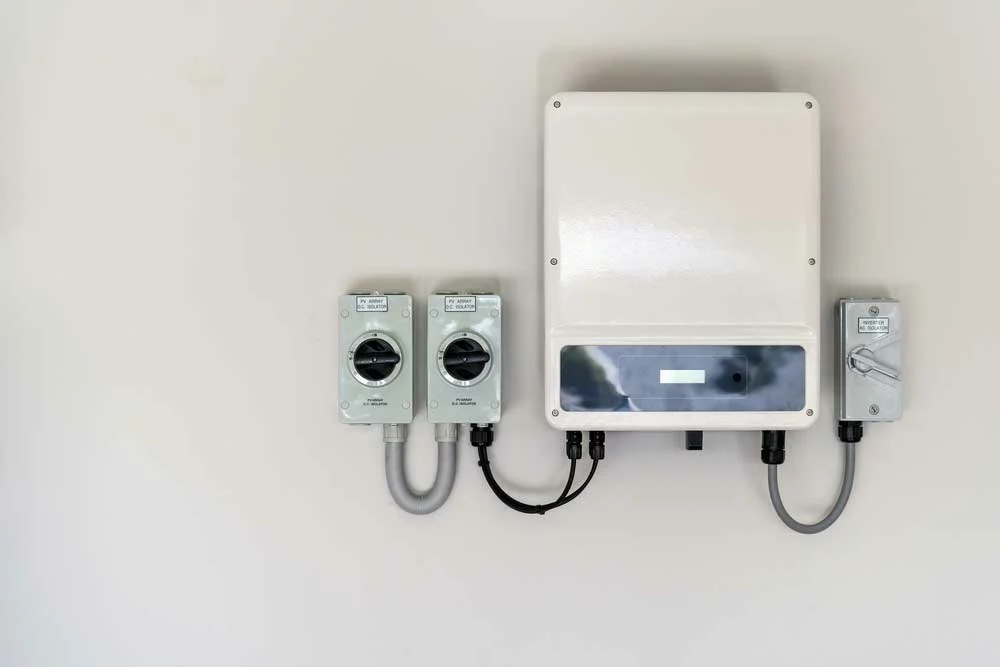
A solar panel inverter
Benefits of Solar Inverters
Besides converting DC to AC, inverters have the following benefits.
Utility Grid Communication
Utility companies shut off the grid sometimes to do maintenance or repair work.
However, solar panels don’t stop generating power and can cause electric shock hazards to line workers.
Inverters communicate with the grid and cut off the power supply when they detect power outages.

A hybrid solar inverter
Besides that, the devices also keep tabs on your battery bank’s status and home power consumption to determine if you can supply power to the grid. Doing so helps maximize your net energy credits.
Power Output Monitoring
A solar system’s power output varies depending on factors such as the sun’s intensity. An inverter monitors this power output to measure the unit’s performance.
Advanced units give these performance metrics on a web application or mobile app so that you can observe the power output from your laptop or mobile device.
Also, some send alerts when they detect inefficiency or component issues.
Maximizes Energy Production
By monitoring the power output, inverters help maximize power production. High-quality inverters go the extra mile to produce AC with purer sine waves that are ideal for sensitive devices due to the smoothness of the power.
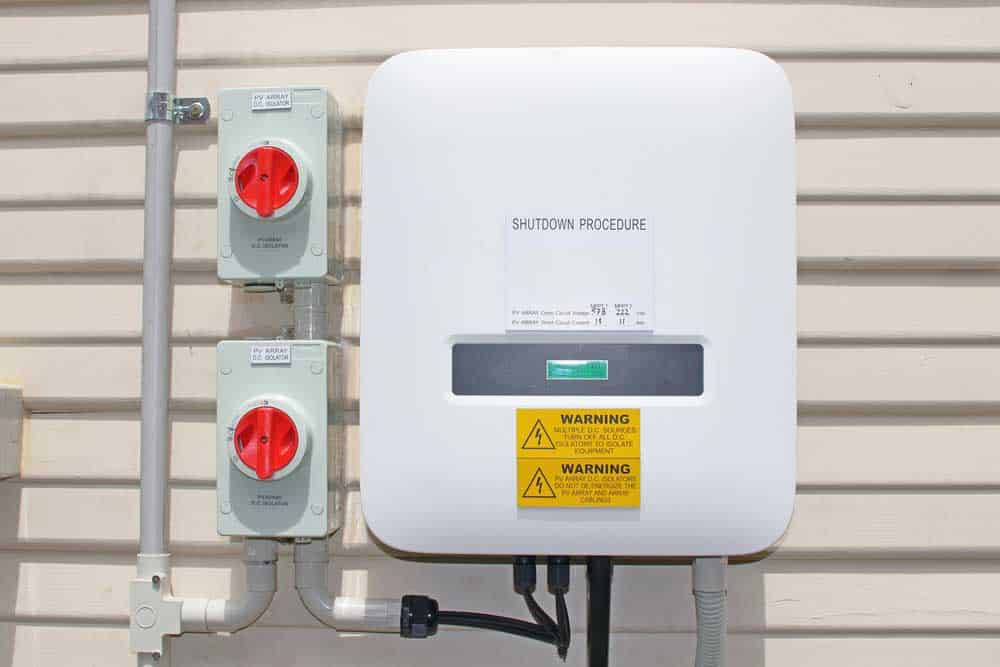
A solar inverter with isolating switches
Fault Detection
Solar panels, batteries, and wiring tend to degrade as they age. This degradation can be hazardous due to ground faults and arcing, especially if you neglect maintenance.
Inverters can detect such issues and cut off the power supply to protect themselves and the entire solar energy system.
Types of Inverters
Solar inverters come in different types to suit varying customer conditions, such as the following.
- Roof complexity
- Frequency and extent of shade on the solar panels
- The purpose of solar power usage
- Utility company guidelines in your area
- Manufacturer’s contract
With these factors in mind, you can pick one of these inverter types.
Solar Micro-Inverter
Micro-inverter systems are the most compact grid-tied systems in the market in function and size. E
ach unit can support a single solar panel and gets installed near the module, enabling them to work independently.
Micro-inverters are also quick and safe to install but are expensive and require more upkeep.
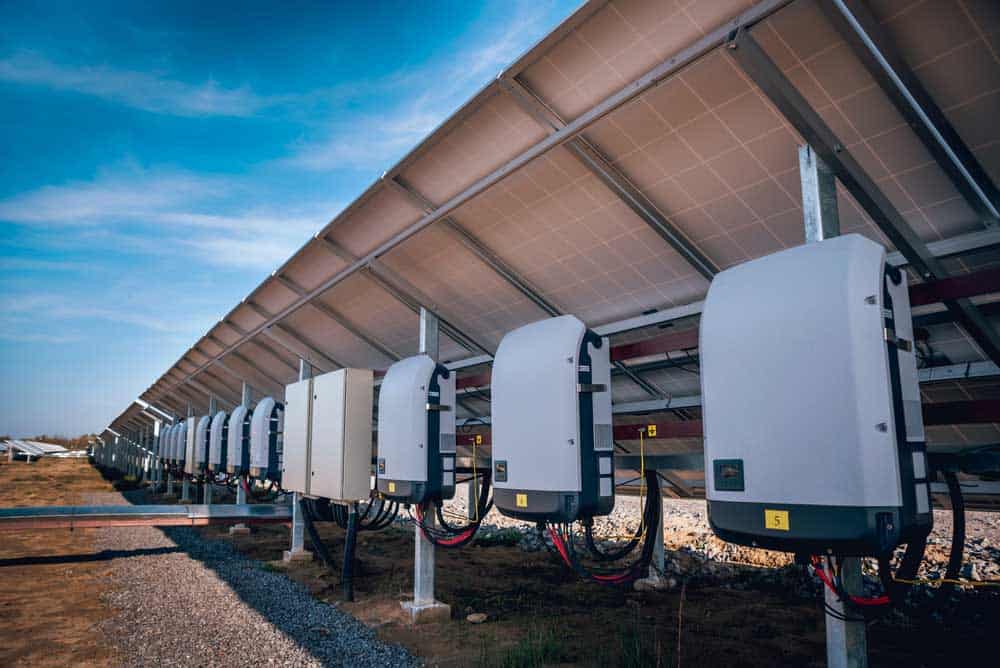
Multiple inverters are installed under solar panels.
Off-Grid Inverter (Battery Inverter)
Off-grid inverters are ideal for standalone solar energy systems where they convert DC power from the battery storage to power the home.
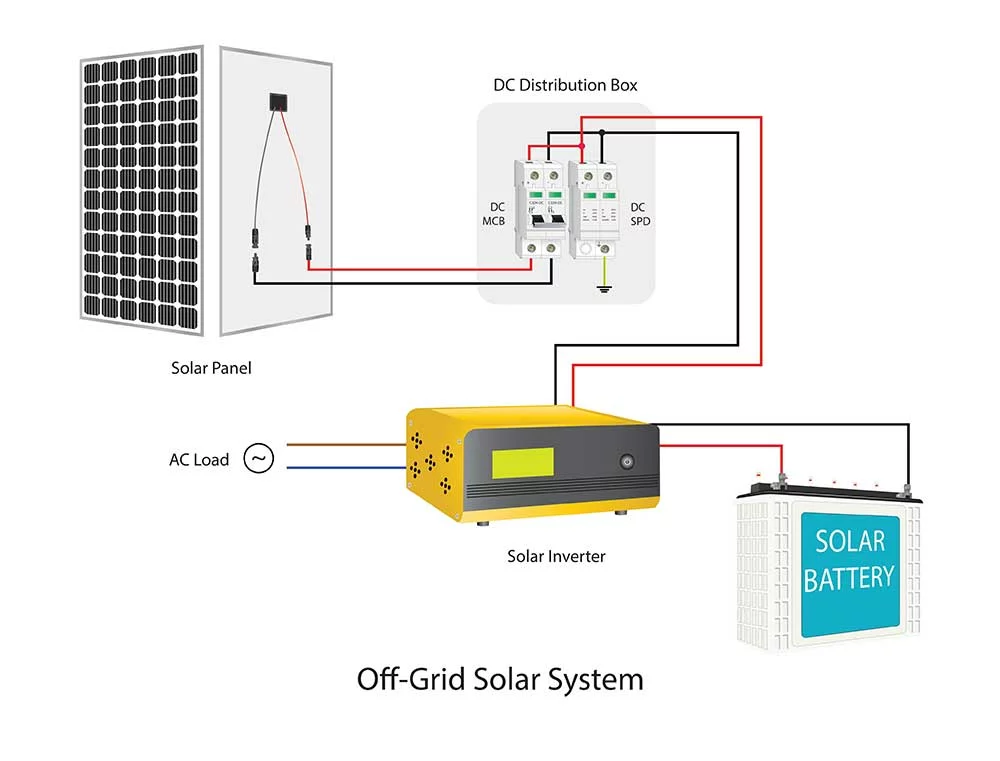
An off-grid or battery inverter
Hybrid Inverter
A hybrid inverter combines an off-grid and grid-tie inverter in one.
So it is battery-ready, and you can hook it up to the power grid. The device’s primary advantage is it does DC-to-AC conversion and vice versa.
Therefore, it can power the home, charge batteries, and supply the grid when the panels generate excess electricity.
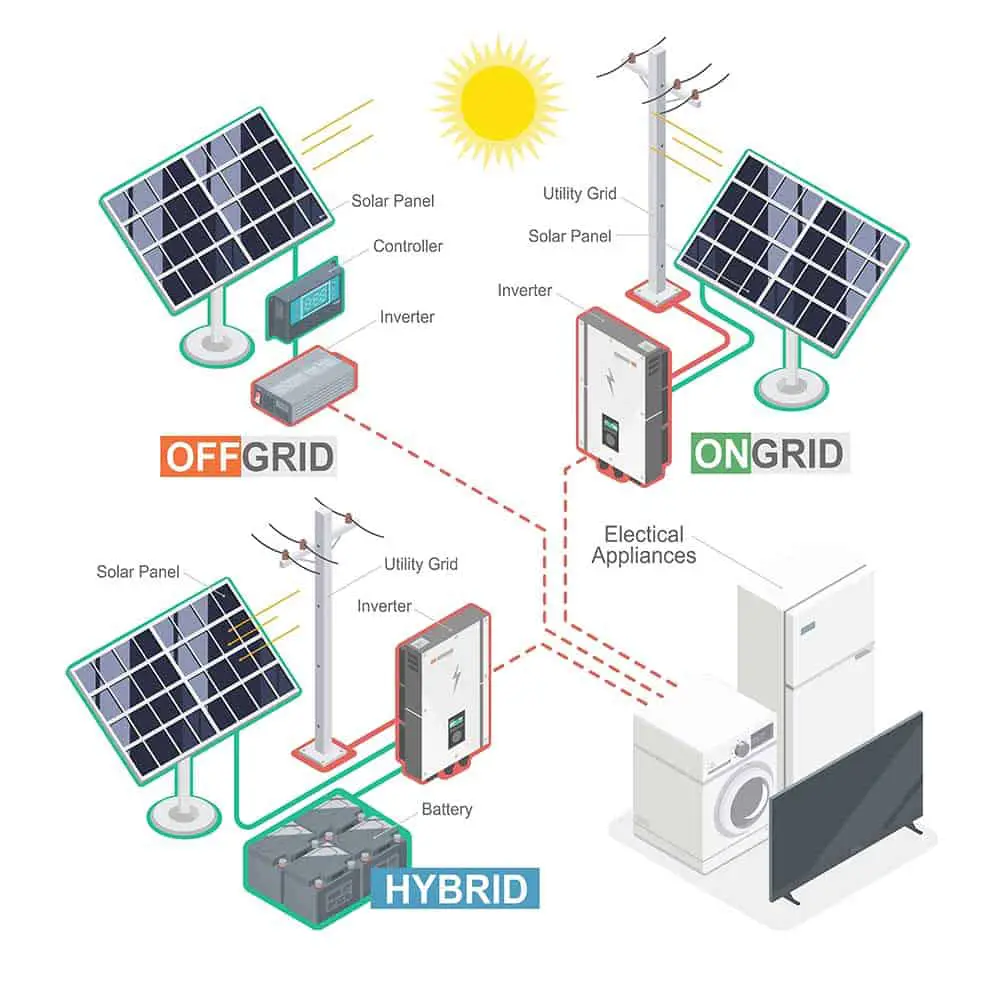
Off-grid vs. grid-tied vs. hybrid solar systems with inverters
But when the sun is not bright, such as in the cold winter, a hybrid inverter can convert AC to DC to act as a battery charger or even a DC charger for electric vehicles.
This design creates backup power if there is a blackout in the grid.
String Inverter
String inverters are the most common type of inverter because they treat a string of solar panels as one unit.
While this setup reduces the installation cost, it reflects any fault in a single panel as a problem in the system.
Therefore, the AC-generating potential is only as good as the least productive panel in the system.
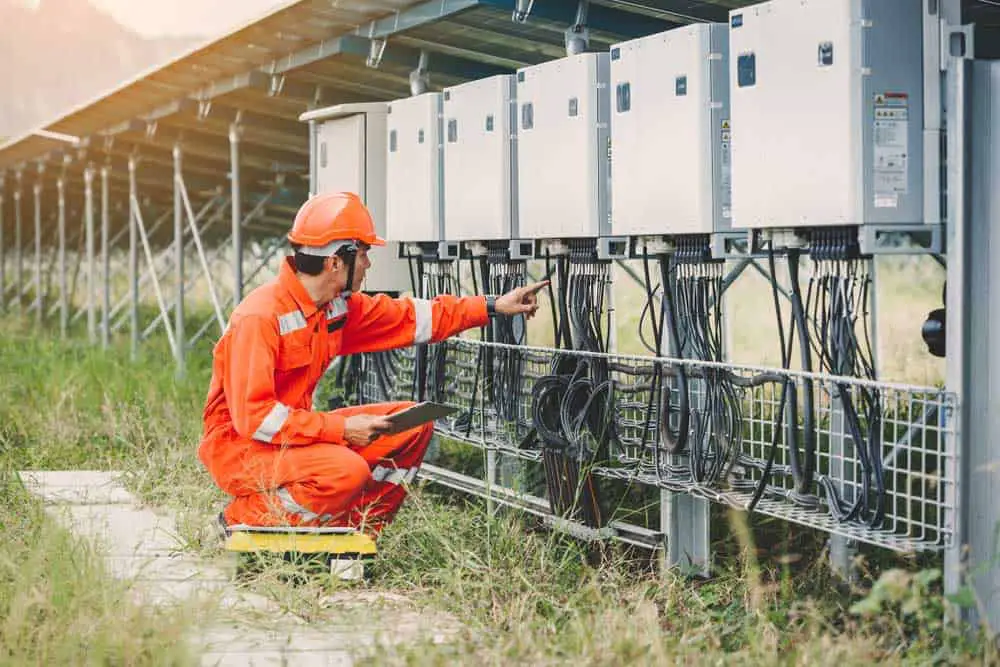
String inverters
Power Optimizers
Inverters with optimizers combine string and micro-inverters in one. In this system, power from each panel goes into an optimizer.
The optimizers offer panel-level monitoring to optimize the electric voltage and provide maximum output power. Also, they minimize the shading impact on any panel but do not convert DC to AC.
They supply the central inverter for DC to AC conversion.
Best Solar Inverters: Factors To Consider When Choosing a Solar Inverter
Efficiency
Solar power inverters are not 100% efficient. They use some of that power in the conversion process, so the peak efficiency is about 90% to 96%. Some go to 97%, and the closer the number is to 100%, the better.
Capacity
A solar inverter should match the wattage produced by the solar panels to function effectively.
For instance, if you have four solar panels with a maximum output power of 220 watts each, you need a string inverter with a 900-1000 watts rating.
Most string inverters have a capacity of 3-7kWh to match the combined power output of multiple panels.
Solar Monitoring
Not all inverters have a solar monitoring feature. But some feature mobile-app or web-based solar power monitoring to help you track power production in real-time.

A complete solar installation with an inverter
Ease of Installation
Solar inverter manufacturers should include the required mounting hardware and provide instructions with pictures for guidance.
Some go the extra mile of pre-wiring the system, making it less complex.
Without these ease of installation features, you might have to employ a professional to set up the device, which is an additional cost.
Durability
Inverters usually last and perform optimally as per the product warranty period.
Therefore, you should buy units with at least a 5-year warranty. 25-year warranties are better to match the solar cell product warranty.
Safety
Anti-island protection is critical for inverters because it disconnects them from the electrical grid in case of a power outage.

Solar panels supply power to the grid
Cost
The average cost of any solar inverter type ranges from $1,000 to $2,000, with the size and classification determining the price. But you can take advantage of solar tax credits to lower the cost.
For instance, the federal tax credit program for solar systems in 2022 is 30%. So you can get $6,000 in credit for a system that costs $20,000 (which includes the inverter’s cost).
Best Solar Inverters
Best Solar Inverters:
Fronius Primo Grid-Tied Inverter Single-Phase Dual MPPTs
This grid tie inverter has the necessary equipment that meets the technical requirements of supplying power to an intelligent power grid.
Also, it features an LCD and an integrated data communication system for advanced monitoring of each solar system.
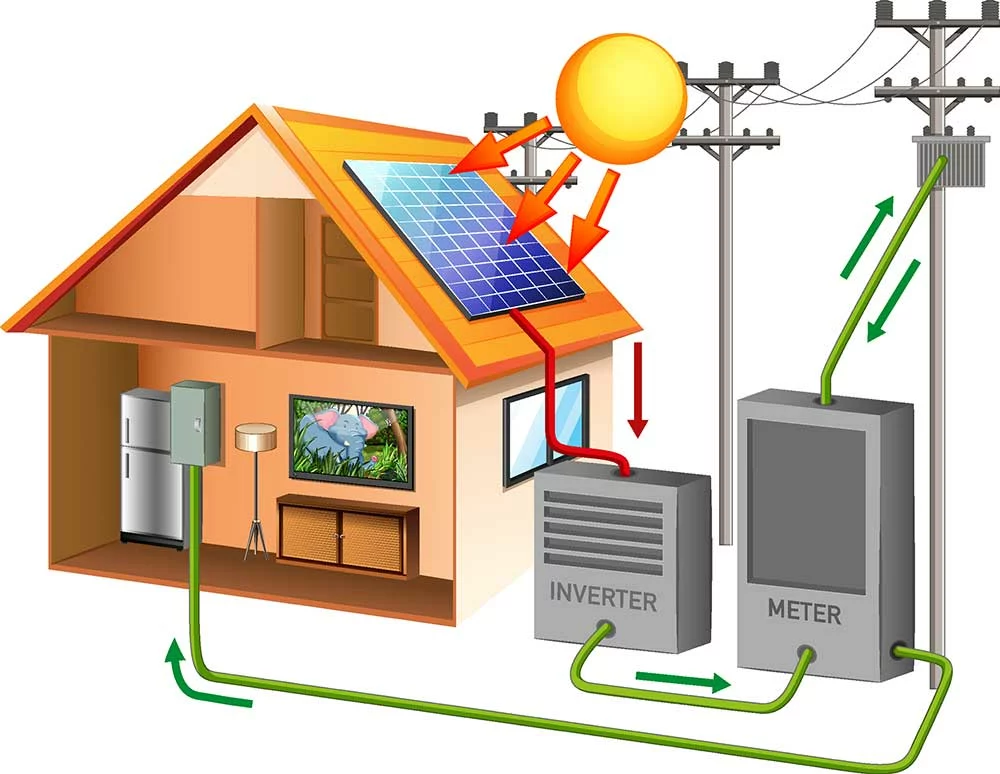
A grid-tied solar power inverter
The unit has a lightweight design and features SnapInverter technology with a standardized hinge mounting system, making installation a breeze.
Primo inverters are available in different models, with conversion efficiencies exceeding 95% for each.
Best Solar Inverters:
SolarEdge HD Wave Inverter
One outstanding feature of the SolarEdge HD-wave inverter is its maximum efficiency (99%), arguably the highest efficiency rating in the solar industry.
SolarEdge redefined the inversion process by implementing distributed switching plus powerful DSP processing.
This combination creates a smooth wave inverter without heavy processing and cooling elements.

A solar power inverter in a domestic installation
The device integrates with the SolarEdge SetApp app platform for quick and easy commissioning from a smartphone. And it comes with 12-25 year warranty options for different models.
Best Solar Inverters:
SMA Sunny Boy Inverter
SMA’s ShadeFix and its integrated web interface for remote control (commissioning) enable this inverter to yield maximum power to run your home and supply the grid.
After all, a solar project is an investment that should give high returns.
The grid tie inverter has no LCD. Display-less inverters are more popular nowadays because digital displays fail over time in outdoor environments.
So the web interface is better, and SMA made it intuitive for easy use.
Conclusion
In summary, solar inverters are critical electronic devices in solar power systems because they convert DC to AC (sometimes vice versa).
They come in different types, and you should pick the one that suits your installation. That’s it for this article. Thanks for your time.
